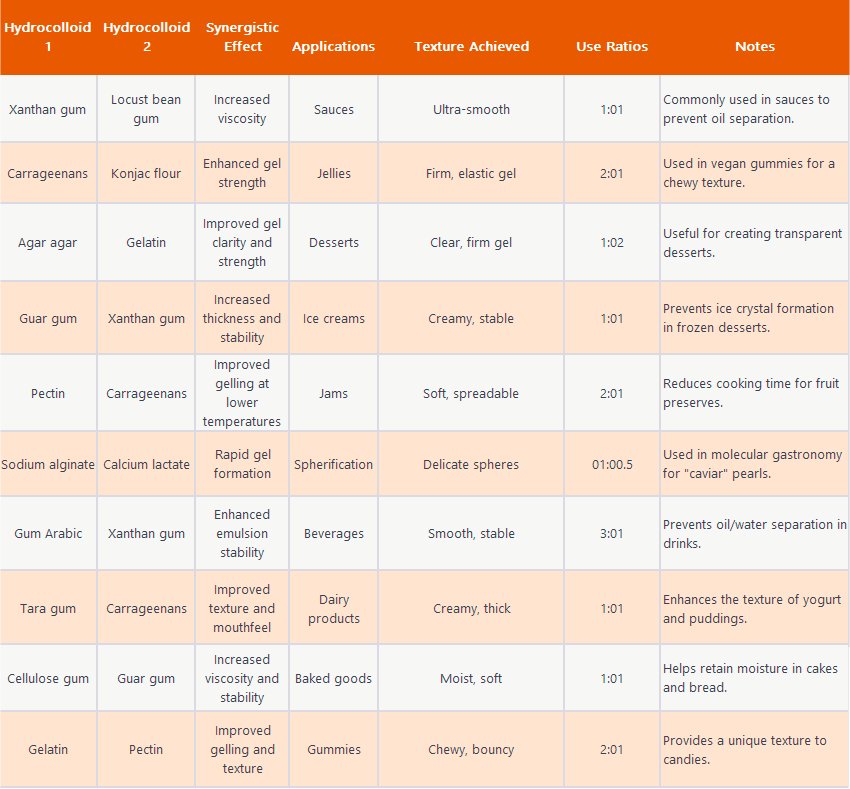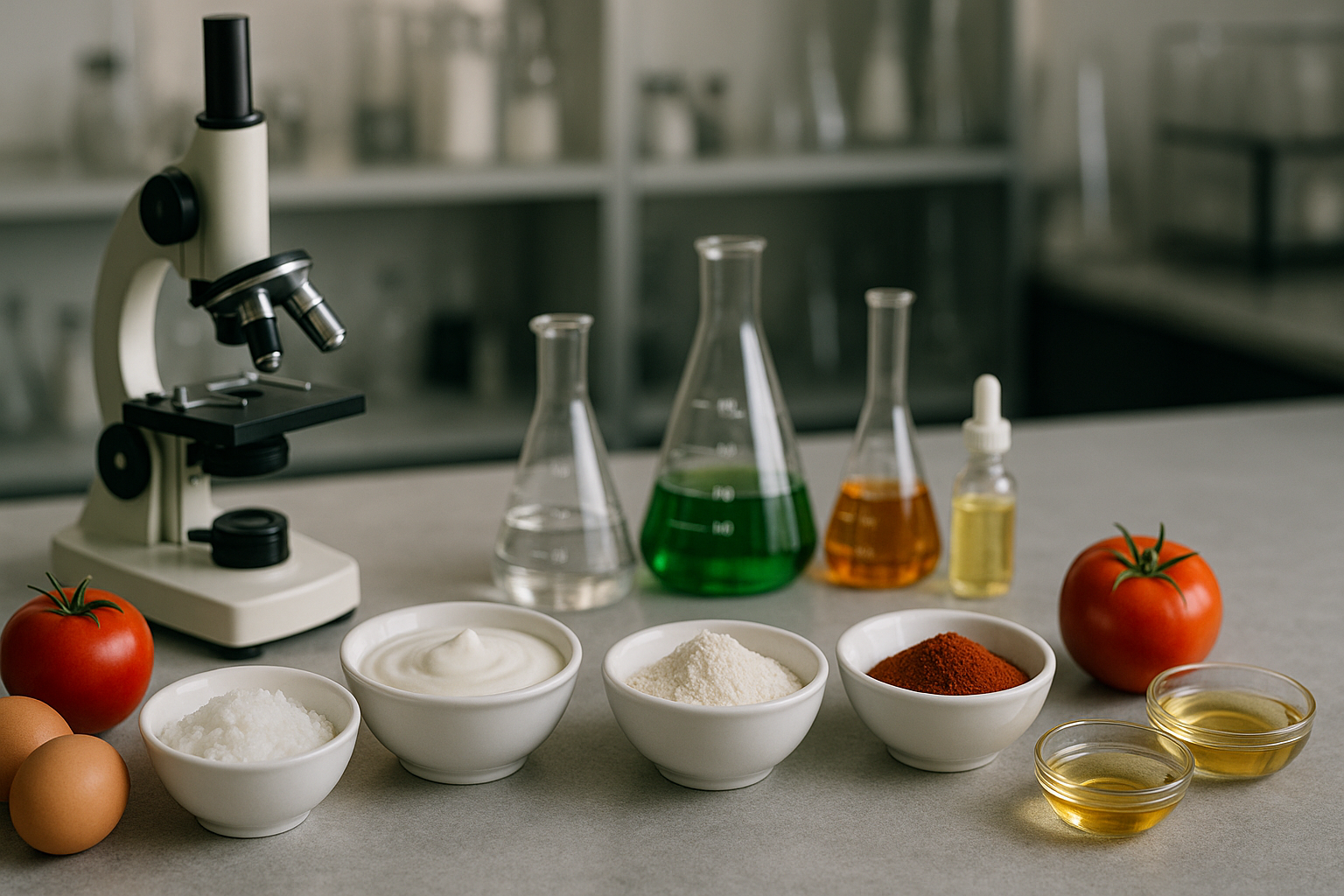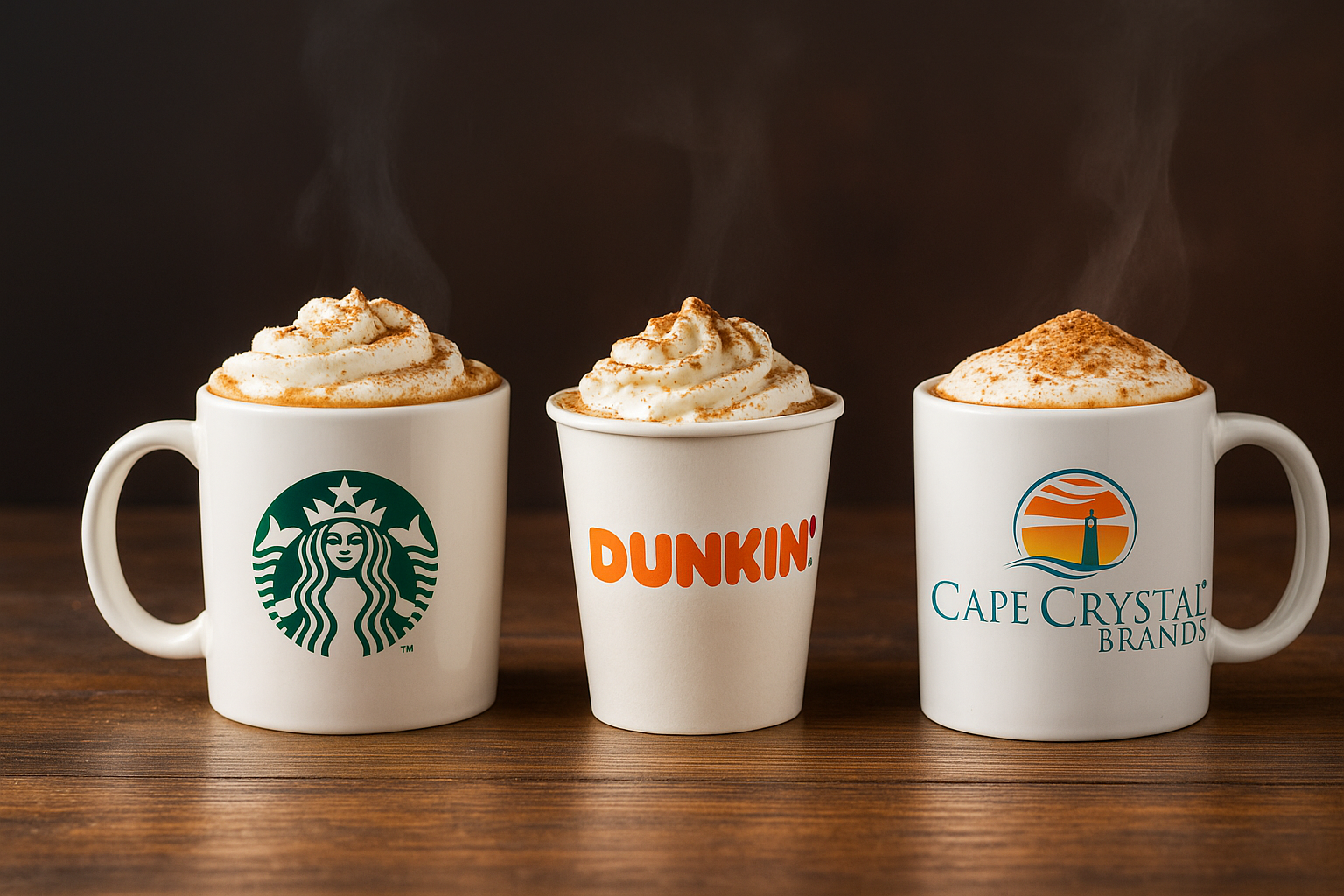
Selecting the Right Hydrocolloid for Your Recipe
SUBSCRIBE TO OUR BLOG
Promotions, new products, and recipes.
As a professional cook, I know that adding the right hydrocolloid to your recipe can make a world of difference in the final product. Hydrocolloids are substances that can change the texture and viscosity of food, making it smoother, creamier, or thicker. They can also help to stabilize emulsions and prevent separation.
Whether you are making a vegan dish, gluten-free baked goods, sauces, or ice cream, hydrocolloids can be a game-changer. Not only can they enhance the texture and flavor of the food, but they can also provide health benefits such as improved digestion and weight management.
In this article, we will explore the different types of hydrocolloids used in cooking and their various applications. We will also provide practical tips on how to determine the appropriate amount of hydrocolloid to add to your recipe. Get ready to take your cooking skills to the next level!
Key Takeaways:
- Hydrocolloids can enhance the texture and stability of food.
- They are commonly used in vegan, gluten-free, dairy, meat, and baked goods recipes.
- Hydrocolloids can provide health benefits such as improved digestion and weight management.
- Determining the appropriate amount of hydrocolloid to add to your recipe is important for optimal results.
- Experimenting with different hydrocolloids can lead to new and exciting culinary creations.
The Role of Hydrocolloids in Food
Hydrocolloids are a diverse group of natural or synthetic substances that are widely used in the food industry. These compounds have unique properties that make them ideal for various food applications, including thickening, gelling, stabilizing, emulsifying, and controlling moisture.
There are many different types of hydrocolloids, but most are obtained from natural sources such as plants, seeds, and seaweeds. Some of the most common natural hydrocolloids used in food include carrageenan, agar, pectin, xanthan gum, and guar gum. In addition to their natural counterparts, synthetic hydrocolloids like carboxymethyl cellulose (CMC) and methylcellulose (MC) are also widely used in the food industry.
Hydrocolloids play a vital role in food production, especially in achieving the desired texture, stability, and mouthfeel of various food products. For instance, the addition of xanthan gum to a salad dressing can prevent the ingredients from separating and provide a smooth, creamy texture. Meanwhile, carrageenan is an essential ingredient in many dairy-based products like ice cream and cheese, as it helps improve texture, prevents syneresis, and enhances creaminess.
Natural Hydrocolloids
Natural hydrocolloids are derived from various sources, including plants, seaweed, and animal products. These hydrocolloids have unique properties that make them ideal for various food applications, such as thickening, gelling, stabilizing, and emulsifying.
| Hydrocolloid | Source | Properties | Applications |
|---|---|---|---|
| Carrageenan | Seaweed | Thickening, stabilizing, gelling | Dairy products, pet food, processed meat |
| Pectin | Fruits | Gelling, thickening | Jam, jelly, confectionery |
| Agar | Seaweed | Gelling, stabilizing | Desserts, jelly, confectionery |
| Guar gum | Seeds | Thickening, stabilizing | Bakery, dairy, processed meat |
| Xanthan gum | Bacteria | Thickening, stabilizing | Salad dressing, sauces, bakery |
Natural hydrocolloids offer several advantages over synthetic ones, including clean-label advantages and a higher degree of acceptance by health-conscious consumers.
In summary, hydrocolloids play a vital role in the food industry, and their versatility and unique properties have transformed the way we produce and enjoy food. The use of hydrocolloids in food has enabled food manufacturers to create new and innovative products, and has also made it possible to provide consumers with products that are safe, nutritious, and of high quality.
Hydrocolloids in Gluten-Free Products
For those with gluten sensitivities, finding suitable alternatives to traditional wheat-based products can be a challenge. Fortunately, hydrocolloids offer a solution with their ability to provide structure and texture to gluten-free baked goods.
One of the most commonly used hydrocolloids in gluten-free baking is xanthan gum. It acts as a binder, helping to hold ingredients together and create a cohesive batter or dough. In addition, xanthan gum helps to prevent crumbling and improve the elasticity of gluten-free baked goods.
Another popular option is guar gum, which can be used in combination with xanthan gum for even better results. Guar gum also helps to improve texture and reduce crumbling, while also providing a creamy mouthfeel to dairy-free recipes.
Other hydrocolloids used in gluten-free baking include carrageenan, which can help to improve the creaminess of dairy-free ice cream, and konjac gum, which can provide a chewy texture similar to traditional wheat-based products.
To achieve optimal results when using hydrocolloids in gluten-free baking, it's important to follow the recommended guidelines and use the appropriate amount for the specific recipe. Generally, hydrocolloids should be used in small quantities, usually no more than 1-2% of the total weight of the ingredients.
By incorporating hydrocolloids into gluten-free recipes, individuals with gluten sensitivities can enjoy a wider range of delicious and satisfying baked goods.
Hydrocolloid Usage Rate Table

Hydrocolloids in Dairy Products
Hydrocolloids are widely used in the dairy industry to improve the quality and stability of various dairy-based products, including yogurt, ice cream, and cheese.
One of the most commonly used hydrocolloids in dairy products is carrageenan, a seaweed extract that is used to stabilize and thicken dairy products. Carrageenan improves the texture of many dairy products, including chocolate milk, cream cheese, and whipped cream. It also prevents syneresis in dairy products, which is the separation of liquid from solid components, ensuring a smooth and consistent product.
Xanthan gum is another popular hydrocolloid used in the dairy industry. It is used to improve the viscosity and mouthfeel of dairy products, including ice cream, sour cream, and cheese. Xanthan gum also improves the stability of dairy products, preventing the formation of ice crystals in ice cream and preventing the separation of whey and curd in cheese.
Guar gum is a third hydrocolloid commonly used in dairy products. It is used to thicken and stabilize yogurt and other cultured dairy products, as well as to improve the texture and mouthfeel of ice cream.
Overall, hydrocolloids play a crucial role in improving the stability, texture, and overall quality of dairy-based products. By using the right hydrocolloid in the right amount, dairy manufacturers can create products that are more appealing and satisfying to consumers.
Hydrocolloids in Meat Products
Hydrocolloids are commonly used in meat products to enhance texture, juiciness, and tenderness. They also play a crucial role in binding and emulsifying meat products, creating a stable and uniform product.
One of the most commonly used hydrocolloids in meat products is carrageenan, derived from red seaweed. Carrageenan is used as a binding agent in meat products such as sausages, burgers, and meatloaf, where it helps to improve the texture and prevent fat separation.
Gellan gum is another hydrocolloid that has gained popularity in meat products. It is used in products where a gel-like texture is desired, such as in some meat snacks and jerky. Gellan gum also provides a smooth mouthfeel, making for a more enjoyable eating experience.
Xanthan gum, a natural gum derived from fermented corn sugar, is often used in processed meat products to improve the texture, prevent syneresis, and stabilize the product. It also helps to create an even distribution of fat throughout the meat, resulting in a more consistent and juicy product.
Application of Hydrocolloids in Meat Products
Hydrocolloids can be added to meat products in various ways, depending on the desired outcome. In ground meat products, hydrocolloids are often added as dry powders to the meat mixture. They are then hydrated with water or other liquid components, such as vinegar or soy sauce, and mixed thoroughly. This helps to evenly distribute the hydrocolloid throughout the meat mixture, improving the binding and emulsifying properties.
In meat products that require a specific texture, such as whole-muscle products, hydrocolloids may be injected or marinated into the meat. This helps to create a more uniform product, with a consistent texture and moisture content.
In conclusion, hydrocolloids play a crucial role in meat products, enhancing texture, juiciness, and tenderness, while also providing binding and emulsifying properties. Carrageenan, gellan gum, and xanthan gum are some of the commonly used hydrocolloids in meat products, each with their unique properties and applications.
Hydrocolloids in Baking
Baking is all about precision and getting the perfect texture and structure for your baked goods. This is where hydrocolloids come in handy. They can change the texture and quality of baked goods, making them more enjoyable to eat.
Common hydrocolloids used in baking include xanthan gum, guar gum, and carrageenan. These are natural ingredients that can improve the texture and structure of your baked goods. They can also help to extend the shelf life of your baked goods.
Xanthan gum, for example, is commonly used in gluten-free baking to provide structure and stability. It can also help to hold moisture in the baked goods, preventing them from becoming dry and crumbly. Guar gum is another natural hydrocolloid that can provide similar benefits.
In addition to improving structure and stability, hydrocolloids can also help to enhance the flavor and appearance of baked goods. Carrageenan, for example, can help to create a smooth texture in custards and puddings, while also improving the overall mouthfeel.
Using Hydrocolloids in Baking
When using hydrocolloids in baking, it's important to use them in the right quantities. Too much hydrocolloid can result in a gummy or slimy texture, while too little may not provide the desired effects. Start with small quantities and adjust as needed to achieve the desired results.
Hydrocolloids can be added to baking recipes in a few different ways. Some recipes may call for the hydrocolloid to be mixed with other dry ingredients before being added to the recipe. Other recipes may call for the hydrocolloid to be mixed with water or other liquids before being added. Follow the recipe instructions carefully to ensure you're using the hydrocolloid correctly.
Overall, hydrocolloids can be a valuable addition to your baking arsenal. They can help to create the perfect texture and structure in your baked goods, while also improving their overall quality and appearance.
Hydrocolloids in Food Preservation
When it comes to preserving food, hydrocolloids play a crucial role. Hydrocolloids are used to prevent moisture loss, extend shelf life, and maintain the quality and appearance of various food products. They are natural, safe, and effective solutions that can replace synthetic additives and preservatives.
One common example is the use of hydrocolloids in fruit preserves and jams. Pectin, a natural hydrocolloid found in fruits, is used as a gelling agent to create a thicker texture and enhance the flavor of the product. Without pectin, the preserve would be runny and prone to spoilage.
Hydrocolloids are also used in meat products to prevent dehydration and maintain juiciness. Carrageenan, a natural hydrocolloid derived from seaweed, is commonly used in processed meat products, such as sausages and deli meats, to improve texture and prevent moisture loss. It also helps to bind different ingredients together, creating a cohesive and uniform product.
In addition, hydrocolloids are used in dairy products to prevent syneresis, which is the separation of liquids from solids. Sodium alginate, another natural hydrocolloid derived from seaweed, is commonly used in ice cream to provide a smooth and creamy texture while preventing ice crystals from forming. It also helps to improve the mouthfeel and stabilize the product during storage.
Overall, hydrocolloids offer a natural and effective way to preserve food and enhance its quality. By using hydrocolloids, we can reduce the need for artificial preservatives and additives, leading to healthier and more sustainable food products.
Hydrocolloids in Sauces
As a copywriting journalist, I've discovered the incredible benefits of using hydrocolloids in sauces. Hydrocolloids are the secret ingredients that help create smooth, flavorful, and stable sauces. They're used to thicken, emulsify, enhance texture, and improve mouthfeel, among other things.
Some common hydrocolloids used in sauces include xanthan gum, carrageenan, and guar gum. Xanthan gum is perfect for thickening sauces, while carrageenan is used for emulsification. Guar gum works wonders in enhancing mouthfeel and texture.
When using hydrocolloids in sauces, it's important to follow the recommended amounts closely. Adding too much can cause the sauce to become too thick or have an unpleasant mouthfeel, while adding too little may not produce the desired result.
Experiment with different hydrocolloids to discover which ones work best for your desired outcome. It can transform a simple sauce into a culinary masterpiece.
Hydrocolloids in Ice Cream and Beverages
When it comes to ice cream and beverages, hydrocolloids play a crucial role in achieving the desired texture and stability. In ice cream, hydrocolloids help to thicken the mixture, prevent ice crystal formation, and improve the overall creaminess.
One common hydrocolloid used in ice cream is guar gum, which helps to improve the texture and mouthfeel. Another popular option is carrageenan, which is known for its ability to prevent melt-down and enhance stability.
In beverages, hydrocolloids can be used to create a smooth and consistent texture, as well as to improve the mouthfeel and appearance. One example is xanthan gum, which can be added to smoothies and other drinks to prevent separation and improve texture.
Another hydrocolloid commonly used in beverages is pectin, which can help to thicken the liquid and create a more satisfying texture. Pectin is often used in the production of juices and fruit-based beverages.
Overall, hydrocolloids are an important ingredient in both ice cream and beverages. They help to create a satisfying texture, prevent separation, and enhance overall stability.
Hydrocolloids in Vegan Products
As a vegan, I know how challenging it can be to find suitable alternatives for dairy and animal-based products. Hydrocolloids play a vital role in creating vegan recipes that mimic the texture, appearance, and mouthfeel of traditional animal-based products.
One of the most commonly used hydrocolloids in vegan products is agar-agar, a natural seaweed-derived gelling agent. Agar-agar is often used as a replacement for gelatin, providing a similar texture and consistency in desserts, jellies, and even savory dishes.
Xanthan gum is another popular hydrocolloid in vegan cooking, providing thickening and stabilizing properties to sauces, dressings, and baked goods. It can also be used as a replacement for eggs in vegan baking, providing the necessary binding properties.
Carrageenan is another natural hydrocolloid derived from seaweed and commonly used in vegan products, including non-dairy milk and ice cream. It provides a creamy, smooth texture and prevents separation, making it an excellent alternative to dairy-based products.
Other hydrocolloids that are commonly used in vegan products include guar gum, locust bean gum, and konjac gum, each with their own unique properties and applications.
Using Hydrocolloids in Vegan Recipes
When using hydrocolloids in vegan recipes, it's important to follow the recommended guidelines and experiment with different ratios to find the ideal balance for your desired texture and consistency. Remember that a little bit goes a long way, and adding too much hydrocolloid can result in a gummy or slimy texture.
It's also essential to consider the type of hydrocolloid when using it in recipes. Some hydrocolloids, such as carrageenan, may require additional heat or acidic environments to activate their gelling properties. Others, such as xanthan gum, may require blending or whisking to prevent clumps from forming.
Incorporating hydrocolloids into vegan recipes can take some experimentation and practice, but the results can be transformative. With the right hydrocolloid, you can create delicious, dairy-free ice cream, creamy sauces, and even vegan cheese that rival their animal-based counterparts.
Hydrocolloid Ingredient Synergy Table

This table shows the synergistic effects of combining two compatible hydrocolloids in the same recipes. The use column indicates the ratio of each ingredient to use.
Health Benefits of Hydrocolloids
Did you know that hydrocolloids can offer a range of health benefits beyond improving the texture and stability of your favorite dishes?
One significant advantage of hydrocolloids is their ability to improve digestion. When hydrocolloids are ingested, they absorb water and increase in size, forming a gel-like substance in the gut. This gel creates a barrier that slows down the digestion process, allowing for better absorption of nutrients and preventing spikes in blood sugar levels.
Additionally, hydrocolloids can aid in weight management by increasing satiety, or feelings of fullness, without adding excess calories. They can also help reduce calorie intake by replacing fat and sugar in recipes without compromising flavor or texture.
Some hydrocolloids, such as psyllium and guar gum, have been shown to have cholesterol-lowering effects. These soluble fibers bind to cholesterol in the gut, preventing its absorption and reducing overall levels in the body.
Overall, incorporating hydrocolloids into your diet can not only enhance your culinary creations but also provide potential health benefits. As always, it's essential to enjoy these ingredients in moderation and as part of a balanced diet.
How Much Hydrocolloid to Add
Adding the right amount of hydrocolloid to your recipe is crucial for achieving the desired texture and consistency. The amount of hydrocolloid you need to add depends on various factors, such as the type of hydrocolloid, the desired texture, and the recipe's ingredients. Here are some general tips to help guide you:
| Type of Hydrocolloid | Recommended Amount |
|---|---|
| Xanthan gum | 0.1-0.5% of total weight |
| Guar gum | 0.1-0.5% of total weight |
| Carrageenan | 0.05-0.3% of total weight |
| Agar agar | 0.2-1.0% of total weight |
Remember, it's essential to add hydrocolloids in small increments while continuously mixing the recipe. This will allow you to monitor how the hydrocolloid affects the texture and adjust accordingly. Generally, it's best to start with a small amount and gradually increase it until you achieve the desired texture. Adding too much hydrocolloid can result in a gummy or rubbery texture, so be cautious and patient with your additions.
Lastly, keep in mind that hydrocolloids can take some time to hydrate fully. Therefore, it's best to mix the hydrocolloid with a small amount of liquid before adding it to the recipe fully. This will ensure that the hydrocolloid has enough time to hydrate and achieve its full potential.
Conclusion
Incorporating hydrocolloids into your recipe can be a game-changer in achieving the desired texture, stability, and mouthfeel of your dishes. With the wide range of natural and synthetic hydrocolloids available, the possibilities for culinary experimentation are endless. I hope this article has given you insight into the role of hydrocolloids in enhancing flavors, improving stability, and extending shelf life in various food products. Remember to always follow the guidelines and practical tips provided to determine the appropriate amount of hydrocolloid to add to your recipes, based on your desired results. So why not take the next step and try experimenting with different hydrocolloids in your favorite recipes? Who knows, you may just discover a new dish that becomes your new favorite. Happy cooking!FAQ
Q: How do hydrocolloids enhance recipes?
A: Hydrocolloids add texture, stability, and mouthfeel to recipes, enhancing the overall cooking experience.
Q: What is the role of hydrocolloids in food?
A: Hydrocolloids, derived from natural sources, contribute to the texture, stability, and mouthfeel of various foods.
Q: How do hydrocolloids help in gluten-free products?
A: Hydrocolloids play a crucial role in creating the perfect texture and structure in gluten-free baked goods, providing a satisfying alternative for those with dietary restrictions.
Q: How are hydrocolloids used in dairy products?
A: Hydrocolloids are used in dairy products to improve stability, prevent syneresis, and enhance creaminess in various recipes.
Q: What is the role of hydrocolloids in meat products?
A: Hydrocolloids are used in meat products for binding, emulsifying, and enhancing juiciness and tenderness.
Q: How are hydrocolloids used in baking?
A: Hydrocolloids are used in baking to improve texture, extend shelf life, and achieve desired results in cakes, bread, and pastries.
Q: How do hydrocolloids contribute to food preservation?
A: Hydrocolloids prevent moisture loss, extend shelf life, and maintain the quality and appearance of various food products.
Q: How are hydrocolloids used in sauces?
A: Hydrocolloids are used in sauces for thickening, emulsification, and enhancing mouthfeel, resulting in smooth, flavorful, and stable sauces.
Q: What is the role of hydrocolloids in ice cream and beverages?
A: Hydrocolloids contribute to the creamy texture and stability of ice cream, and enhance the mouthfeel and appearance of beverages.
Q: How are hydrocolloids used in vegan products?
A: Hydrocolloids are used in vegan recipes as plant-based alternatives for texture, binding, and emulsification, while maintaining desired characteristics.
Q: What are the potential health benefits of hydrocolloids?
A: Hydrocolloids have potential health benefits, including improved digestion, weight management, and increased satiety.
Q: How do I determine the right amount of hydrocolloid to add?
A: Practical tips and guidelines can help you determine the appropriate amount of hydrocolloid to add to your recipes for optimal results.

|
About the Author Ed is the founder of Cape Crystal Brands, editor of the Beginner’s Guide to Hydrocolloids, and a passionate advocate for making food science accessible to all. Discover premium ingredients, expert resources, and free formulation tools at capecrystalbrands.com/tools. — Ed |
Enjoyed this post? Subscribe to The Crystal Scoop
Food-science tips, ingredient know-how, and recipes. No spam—unsubscribe anytime.
- Choosing a selection results in a full page refresh.



